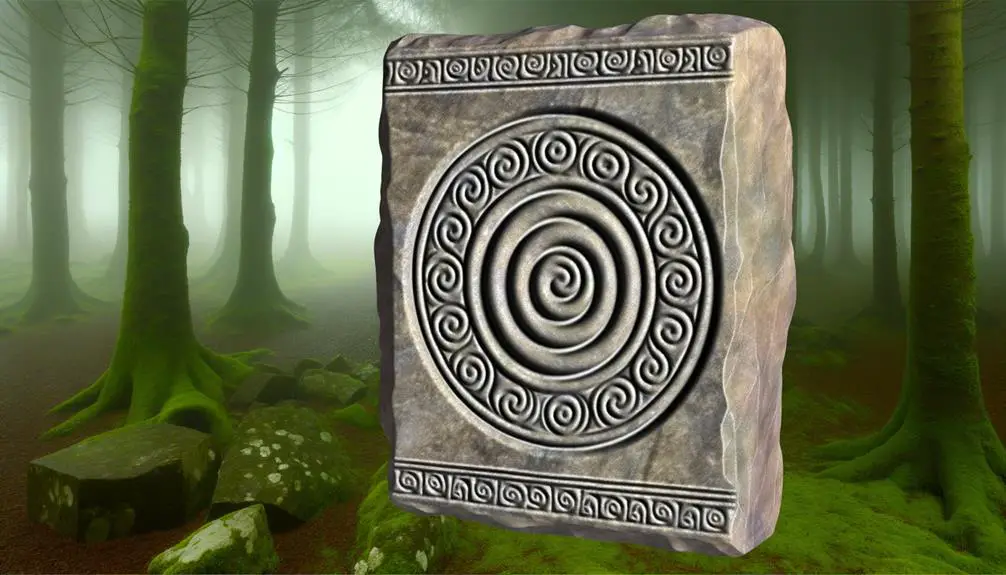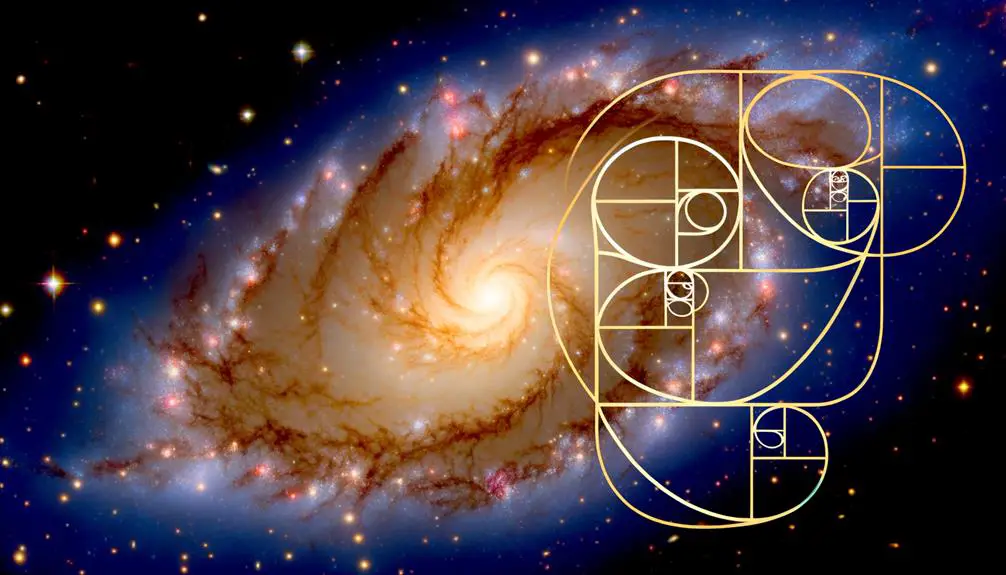Decoding the Spiral Symbol – A Guide to Its Meaning
The spiral symbol, ubiquitous in ancient artifacts and modern interpretations, signifies deep connections to natural and cosmic phenomena. Historically, Celtic spirals embody life's cyclical nature, while Greek art integrates spiral forms from seashells and waves into sacred geometry.
Indigenous traditions in the Americas utilize spirals to represent journeys and transformations. Spirals also denote spiritual and psychological growth, symbolizing personal development and enlightenment.
Scientifically, spirals appear in DNA structures, galaxy formations, and plant growth, emphasizing efficiency and interconnectedness. Artistic and literary uses further reflect themes of infinity, movement, and profound transformation.
Explore how these spiral interpretations resonate across various contexts.

Key Takeaways
- Spirals symbolize the cyclical nature of life and continuous growth.
- They represent personal and spiritual development, evolution, and the journey of self-awareness.
- Spirals in nature, like galaxies and seashells, reflect mathematical principles and cosmic order.
- Various cultures use spirals to signify interconnectedness, transformation, and the cycles of life and death.
- In psychology and spirituality, spirals denote the path to enlightenment and inner harmony.
Ancient Cultural Significance

How did the spiral symbol, with its ubiquitous presence across ancient cultures, come to embody such profound significance in their spiritual and cosmological narratives?
The spiral, present in early rock carvings, pottery, and architecture, reflected a deep connection to natural phenomena such as galaxies, whirlpools, and plant growth patterns.
In ancient Europe, Celtic spirals indicated cycles of life and death. The Greeks, taking cues from nature, saw the spiral in seashells and waves, integrating it into sacred geometry.
Indigenous cultures in the Americas utilized spirals in petroglyphs, signifying journey and transformation.
Each culture's interpretation of the spiral, woven into their mythology and rites, underscores a universal recognition of its intrinsic representation of movement, continuity, and the infinite cycle of existence.
Spiritual and Philosophical Meanings
The spiral symbol has long been associated with profound spiritual and philosophical concepts, representing the journey of evolution and the path toward enlightenment.
Historically, various cultures have interpreted the spiral as emblematic of the cyclical nature of life, reflecting both continuous growth and perpetual renewal.
This symbol encapsulates the idea that life is not linear but rather a series of cycles, each bringing new opportunities for personal and spiritual development.
Symbol of Evolution
Throughout history, the spiral symbol has been revered as an emblem of evolution, signifying the ongoing journey of spiritual and philosophical growth.
This enigmatic form is found across diverse cultures, from the ancient Celts to indigenous tribes, each attributing profound significance to its endless, cyclical nature.
The spiral's structure, expanding outward from a central point, mirrors the unfolding of life, knowledge, and consciousness.
In many spiritual traditions, it represents the soul's progression through stages of enlightenment, encapsulating the idea that growth is non-linear and ever-evolving.
Philosophically, the spiral embodies the dialectical process, where each revolution brings deeper understanding.
Hence, the spiral serves as a potent symbol of continuous development, reflecting humanity's quest for deeper meaning and self-realization.
Path of Enlightenment
Tracing the spiral's intricate curves reveals profound insights into the path of enlightenment, as it encapsulates both spiritual ascension and philosophical introspection across various cultures and historical epochs. This symbol reflects the journey toward higher consciousness and self-awareness, resonating deeply within the human psyche.
Historically, the spiral is seen in:
- Ancient Celtic Art: Representing the soul's journey and the cycles of life.
- Buddhist Mandalas: Depicting the universe's complexity and the path to enlightenment.
- Greek Philosophy: Symbolizing the continuous quest for knowledge and personal growth.
Through these varied cultural lenses, the spiral emerges as a universal emblem of the transformative process towards enlightenment, embodying the perpetual movement towards deeper understanding and spiritual fulfillment.
Cycle of Life
Building upon the spiral's representation of enlightenment, its cyclical nature also embodies the profound spiritual and philosophical meanings attributed to the cycle of life.
Historically, the spiral has signified life's continuous flow, from birth to death and rebirth, reflecting ancient beliefs in regeneration and perpetual renewal. In Celtic culture, spirals carved into stone symbolized this eternal journey.
Similarly, Hinduism's concept of samsara—the cycle of birth, death, and rebirth—echoes the spiral's meaning, emphasizing the soul's evolution. The spiral's recurring form in nature, from galaxies to seashells, further reinforces its universal significance.
Therefore, the spiral not only illustrates the path to enlightenment but also encapsulates the timeless, interconnected cycles intrinsic to human existence.
Natural Occurrences

The spiral symbol is prevalent in nature, manifesting in various forms such as seashell patterns, the structure of galaxies, and the growth patterns of certain plants. Historically, these natural spirals have been studied to understand their mathematical precision and biological significance.
Culturally, they have inspired interpretations that connect the natural world with spiritual and philosophical reflections on the continuity and cycles of life.
Seashell Spiral Patterns
Often regarded as one of nature's most enchanting designs, seashell spiral patterns embody a profound mathematical elegance, appearing across various species and cultures throughout history. These natural spirals follow the Fibonacci sequence, a principle that transcends mere aesthetics to reveal deeper structural truths.
Seashell spirals have been:
- Mathematically analyzed: They exhibit logarithmic spirals, demonstrating nature's inherent mathematical precision.
- Culturally significant: Ancient civilizations, such as the Greeks and Egyptians, revered seashells, incorporating their forms into art and architecture.
- Symbolically rich: Many cultures view the spiral as a symbol of growth, evolution, and cosmic unity.
This intricate design not only evokes admiration but also invites a deeper appreciation of the interconnectedness within the natural world.
Galaxy Spiral Structure
In a similar manner to the seashell's intricate designs, the spiral structures of galaxies provide a profound glimpse into the underlying mathematical and cosmic principles governing the universe.
Historically, the discovery of spiral galaxies by Edwin Hubble in the early 20th century revolutionized our understanding of cosmic architecture. These spirals, often observed through telescopes, reveal patterns driven by gravitational forces and density waves.
Culturally, the spiral form in galaxies has been interpreted as a symbol of infinity and the cyclical nature of existence. The consistent appearance of spirals in vastly different contexts underscores a universal resonance, connecting human perception with the grand, ever-expanding cosmos, thereby enriching our appreciation of both natural and metaphysical phenomena.
Plant Growth Spirals
Numerous plants exhibit spiral growth patterns, a phenomenon intricately tied to the Fibonacci sequence and the golden ratio, reflecting a deep mathematical order in nature.
Historically, this spiral form has been observed in ancient botanical illustrations and described in early scientific texts. The pattern optimizes sunlight exposure and space efficiency, essential for plant survival.
Key examples include:
- Sunflower heads: Seeds are arranged in a double spiral to maximize packing efficiency.
- Pinecones: Scales are positioned in spirals to facilitate seed dispersal.
- Succulent leaves: Arranged spirally to capture maximum light and minimize shadow.
Cultural interpretations often link plant spirals to life's cyclical nature and growth. This natural alignment with mathematical principles underscores a universal interconnectedness, revealing the profound intelligence inherent in biological systems.
Symbolism in Art and Literature
Throughout history, the spiral symbol has been intricately woven into the fabric of art and literature, serving as a powerful motif that conveys themes of growth, transformation, and the cyclical nature of existence.
In classical literature, the spiral often symbolizes life's journey, reflecting the twists and turns of human experience. Artists from various cultures, such as the ancient Celts and Greeks, incorporated spirals into their work to represent eternity and cosmic order.
The Renaissance period saw a re-emergence of the spiral in art, symbolizing intellectual and spiritual ascension. In modern literature, authors like James Joyce use the spiral to signify complex narrative structures and psychological depth.
This enduring symbol transcends time, offering rich interpretive layers across artistic and literary landscapes.
Scientific Perspectives

From a scientific perspective, the spiral symbol is prominently featured in natural phenomena, ranging from the structure of galaxies to the formation of hurricanes and the arrangement of DNA. This ubiquitous pattern has intrigued scientists and scholars for centuries, prompting detailed analysis and exploration.
Key examples include:
- Galaxies: Spiral galaxies like the Milky Way showcase vast, rotating arms, embodying the cosmic scale of the spiral structure.
- Weather Systems: Hurricanes and cyclones naturally form spirals due to the Coriolis effect, demonstrating the symbol's dynamic force in meteorology.
- Biology: DNA's double helix is a molecular spiral, fundamental to genetic coding and life processes.
The recurrence of spirals across various scientific domains underscores their fundamental role in the natural world.
Modern Interpretations
In contemporary culture, the spiral symbol is often interpreted through the lenses of psychology, spirituality, and digital design, reflecting a synthesis of ancient wisdom and modern understanding. In psychology, it represents personal growth and the journey of self-discovery. Spiritually, it signifies the unfolding of consciousness and the cyclical nature of life. In digital design, the spiral is utilized for its aesthetic appeal and dynamic form, symbolizing innovation and forward thinking.
| Domain | Interpretation |
|---|---|
| Psychology | Personal growth, self-discovery |
| Spirituality | Unfolding consciousness, cyclical nature |
| Digital Design | Aesthetic appeal, dynamic form |
| Cultural Symbol | Innovation, forward thinking |
Thus, the spiral continues to be a potent symbol, bridging the past with the present.
Conclusion
The spiral symbol, a timeless motif woven through the tapestry of human history, encapsulates profound cultural, spiritual, and natural significances.
From ancient cultural rites to modern scientific interpretations, the spiral endures as a metaphor for life's journey—a dance between chaos and order.
This symbol's multifaceted presence in art, literature, and philosophy underscores its universal resonance, reflecting humanity's intrinsic quest for understanding and meaning amidst the ever-turning wheel of existence.






